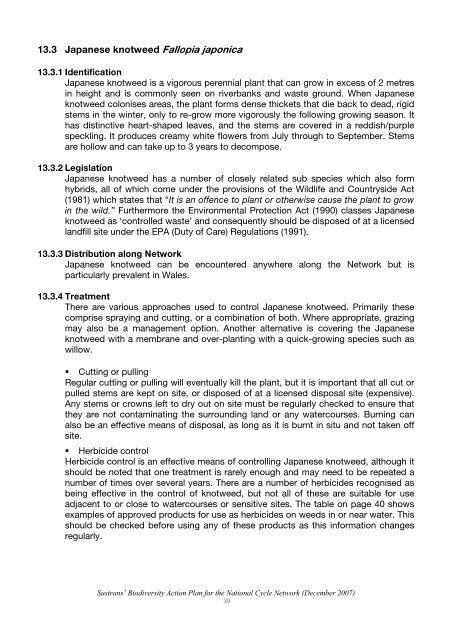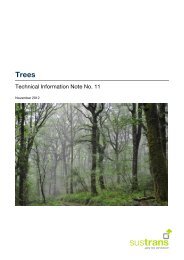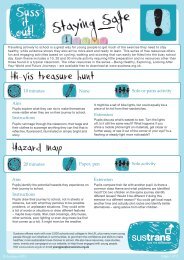Biodiversity Action Plan for the National Cycle Network ... - Sustrans
Biodiversity Action Plan for the National Cycle Network ... - Sustrans
Biodiversity Action Plan for the National Cycle Network ... - Sustrans
You also want an ePaper? Increase the reach of your titles
YUMPU automatically turns print PDFs into web optimized ePapers that Google loves.
13.3 Japanese knotweed Fallopia japonica<br />
13.3.1 Identification<br />
Japanese knotweed is a vigorous perennial plant that can grow in excess of 2 metres<br />
in height and is commonly seen on riverbanks and waste ground. When Japanese<br />
knotweed colonises areas, <strong>the</strong> plant <strong>for</strong>ms dense thickets that die back to dead, rigid<br />
stems in <strong>the</strong> winter, only to re-grow more vigorously <strong>the</strong> following growing season. It<br />
has distinctive heart-shaped leaves, and <strong>the</strong> stems are covered in a reddish/purple<br />
speckling. It produces creamy white flowers from July through to September. Stems<br />
are hollow and can take up to 3 years to decompose.<br />
13.3.2 Legislation<br />
Japanese knotweed has a number of closely related sub species which also <strong>for</strong>m<br />
hybrids, all of which come under <strong>the</strong> provisions of <strong>the</strong> Wildlife and Countryside Act<br />
(1981) which states that “It is an offence to plant or o<strong>the</strong>rwise cause <strong>the</strong> plant to grow<br />
in <strong>the</strong> wild.” Fur<strong>the</strong>rmore <strong>the</strong> Environmental Protection Act (1990) classes Japanese<br />
knotweed as ‘controlled waste’ and consequently should be disposed of at a licensed<br />
landfill site under <strong>the</strong> EPA (Duty of Care) Regulations (1991).<br />
13.3.3 Distribution along <strong>Network</strong><br />
Japanese knotweed can be encountered anywhere along <strong>the</strong> <strong>Network</strong> but is<br />
particularly prevalent in Wales.<br />
13.3.4 Treatment<br />
There are various approaches used to control Japanese knotweed. Primarily <strong>the</strong>se<br />
comprise spraying and cutting, or a combination of both. Where appropriate, grazing<br />
may also be a management option. Ano<strong>the</strong>r alternative is covering <strong>the</strong> Japanese<br />
knotweed with a membrane and over-planting with a quick-growing species such as<br />
willow.<br />
Cutting or pulling<br />
Regular cutting or pulling will eventually kill <strong>the</strong> plant, but it is important that all cut or<br />
pulled stems are kept on site, or disposed of at a licensed disposal site (expensive).<br />
Any stems or crowns left to dry out on site must be regularly checked to ensure that<br />
<strong>the</strong>y are not contaminating <strong>the</strong> surrounding land or any watercourses. Burning can<br />
also be an effective means of disposal, as long as it is burnt in situ and not taken off<br />
site.<br />
Herbicide control<br />
Herbicide control is an effective means of controlling Japanese knotweed, although it<br />
should be noted that one treatment is rarely enough and may need to be repeated a<br />
number of times over several years. There are a number of herbicides recognised as<br />
being effective in <strong>the</strong> control of knotweed, but not all of <strong>the</strong>se are suitable <strong>for</strong> use<br />
adjacent to or close to watercourses or sensitive sites. The table on page 40 shows<br />
examples of approved products <strong>for</strong> use as herbicides on weeds in or near water. This<br />
should be checked be<strong>for</strong>e using any of <strong>the</strong>se products as this in<strong>for</strong>mation changes<br />
regularly.<br />
<strong>Sustrans</strong>’ <strong>Biodiversity</strong> <strong>Action</strong> <strong>Plan</strong> <strong>for</strong> <strong>the</strong> <strong>National</strong> <strong>Cycle</strong> <strong>Network</strong> (December 2007)<br />
39

















